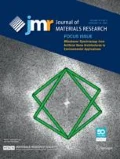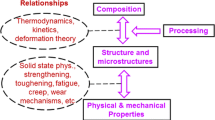Abstract
The mechanical behavior of intermetallic alloys is related to the mobility of the dislocations found in these compounds. Currently the effect of bonding on dislocation core structure and its influence on deformation behavior is not well understood. However, the unusual properties of these materials, such as the anomalous temperature dependence of flow stress observed in TiAl, are derived in part from the aspects of bonding that determine dislocation mobility. Several recent studies have suggested a particular relationship between directional bonding in TiAl and dislocation mobility. To understand better the flow behavior of high temperature intermetallics, and as a step toward bridging the gap between electronic structure and flow behavior, we have calculated the electronic structure of various planar faults in TiAl. The self consistent electronic structure has been determined using a layered Korringa Kohn Rostoker (LKKR) method which embeds the fault region between two semi-infinite perfect crystals. Calculated defect energies in stoichiometric TiAl agree reasonably well with other theoretical estimates, though overestimating the experimental (111) anti-phase boundary (APB) energy, found for Ti46Al54. We approximate the energy of the (111) APB for the Al-rich stoichiometry by calculating the energy of Al antisites near that defect plane. The calculated (111)APB energy decreases by 6% in going from stoichiometric TiAl to Ti46Al54. The overall hierarchy of fault energies is found to be associated with the number of crystal bond states that are disrupted by the introduction of the fault plane. However, the hierarchy of fault energies is inconsistent with the traditionally accepted ordering. Changes in bonding taking place in the vicinity of the planar defects are illustrated through the density of states and charge density plots. A three body atomistic model is introduced to parameterize the bonding observed in TiAl. The L10 lattice (c/a = 1.00), within a second nearest neighbor three body model, yields a (111)APB energy which is the sum of the complex and superlattice-intrinsic stacking fault energies.
Similar content being viewed by others
References
T. Kawabata, T. Kanai, and O. Izumi, Acta Metall. 33, 1355 (1985).
H. A. Lipsitt, D. Shechtman, and R. E. Schafrick, Metall. Trans. 6A, 1991 (1975).
Y. W. Kim and D. M. Dimiduk, JOM 43, #8 (1991).
V. Paidar, D. V. Pope, and V. Vitek, Acta Metall. 32, 435 (1984).
M. H. Yoo, Scripta Metall. 20, 915 (1986).
The asymmetric notation <hk;l] is adopted from G. Hug, A. Loiseau, and P. Veyssière, Philos. Mag. A57, 499 (1988). The notation reflects the tetragonal symmetry of the L10 lattice; the indices h and k may be permuted while the third index is fixed.
G. Hug, A. Loiseau, and A. Lasalmonie, Philos. Mag. A54, 47 (1986); G. Hug, A. Loiseau, and P. Veyssière, Philos. Mag. A57, 499 (1988); G. Hug, Ph.D. Dissertation (1988), University of Orsay (France).
S. A. Court, V. K. Vasudevan, and H. L. Fraser, Philos. Mag. 61A, 141 (1990).
B. F. Greenberg, V. I. Anisimov, and Yu. N. Gornostirev, Scripta Metall. 22, 859 (1988).
G. Hug and P. Veyssière, in Int. Symp. on Electronic Microscopy in Plasticity and Fracture Research of Materials (Dresden, October 1989).
V. I. Anisimov, G. V. Ganin, V. R. Galakhov, and E. Z. Kurmayev, Phys. Met. Metall. 63, 192 (1987).
S.R. Chubb, D.A. Papaconstantopoulos, and B. M. Klein, Phys. Rev. B 38, 12120 (1988).
M. Morinaga, J. Saito, N. Yukawa, and H. Adachi, Acta Metall. 38, 25 (1990).
C.L. Fu and M.H. Yoo, in Alloy Phase Stability and Design, edited by G.M. Stocks, D.P. Pope, and A.F. Giamei (Mater. Res. Soc. Symp. Proc. 186, Pittsburgh, PA, 1991), p. 265; C.L. Fu and M.H. Yoo, Philos. Mag. Lett. 62, 159 (1990).
D.M. Ceperley and B.J. Alder, Phys. Rev. Lett. 45, 566 (1980); D.M. Ceperley, Phys. Rev. B 18, 3126 (1978).
J.P. Perdew and A. Zunger, Phys. Rev. B 23, 5048 (1981).
J.M. MacLaren, S. Crampin, and D.D. Vvedensky, Phys. Rev. B 40, 12164 (1989); X-G. Zhang, A. Gonis, and J. MacLaren, Phys. Rev. B 40, 3694 (1989).
E.S. Bumps, H.D. Kessler, and M. Hanson, Trans. AIME 194, 609 (1952).
W. Lin, J. Xu, and A.J. Freeman, in High Temperature Ordered Intermetallic Alloys IV, edited by L. A. Johnson, D.P. Pope, and J.O. Stiegler (Mater. Res. Soc. Symp. Proc. 213, Pittsburgh, PA, 1991), p. 131; A.J. Freeman, T. Hong, W. Lin, and J. Xu, ibid., p. 31.
C. H. P. Lupis, Chemical Thermodynamics of Material (North Holland, New York, 1983), p. 449.
R. Hultgren, P.D. Desai, D.T. Hawkins, M. Gleiser, and K.K. Kelley, in Selected Values of the Thermodynamic Properties of Binary Alloys (American Society for Metals, Metals Park, OH, 1973), p. 221.
The quasi chemical model has also been used previously to estimate planar fault energies; see, for example: D. Shechtman, M.J. Blackburn, and H.A. Lipsitt, Metall. Trans. 5, 1373 (1974).
These total energy calculations were performed with a maximum angular momentum (lmax) equal to 4. Preliminary electronic structure calculations of these faults, using lmax = 2, are presented in the following citation: C. Woodward, J.M. MacLaren, and S.A. Rao, in High Temperature Ordered Intermetallic Alloys TV, edited by L. A. Johnson, D. P. Pope, and J.O. Stiegler (Mater. Res. Soc. Symp. Proc. 213, Pittsburgh, PA, 1991), p. 715.
J. P. Hirth and J. Lothe, Theory of Dislocations (McGraw-Hill, New York, 1968), p. 432.
S. Tang, Northwestern University, private communication (1991).
D. J. H. Cockayne, I. L. F. Ray, and M. J. Whelan, Philos. Mag. 20, 1265 (1969).
N. Baluc, R. Schaublin, and K.J. Hemker, in Ordered Intermetallics–Physical Metallurgy and Mechanical Behavior (NATO Advanced Research Workshop, Irsee, Germany, June 1991).
R.P. Elliott and W. Rostaker, Acta Metall. 2, 884 (1954).
The stoichiometry is calculated using the distance between anti-sites in the (111) plane as a length scale.
J. M. MacLaren, C. Woodward, and S. Rao, in Application of Multiple Scattering Theory to Materials Science, edited by W. H. Butler, P. H. Dederichs, A. Gonis, and R. Weaver (Mater. Res. Soc. Symp. Proc. 253, Pittsburgh, PA, 1992).
M.J. Marcinkowski, in Electron Microscopy and Strength of Crystals, edited by G. Thomas and J. Washburn (Interscience Publishers, 1963), p. 431; K. Suzuki, M. Ichihara, and S. Takeuchi, Acta Metall. 27, 193 (1979).
B.A. Greenberg, O.V. Antonova, V.N. Indenbaum, L.E. Karkina, A.B. Notkin, M.V. Ponomarev, and L.V. Smirnov, Acta Metall. Mater. 39, 233 (1991).
M. Yamaguchi, V. Vitek, and D.P. Pope, Philos. Mag. 43, 1027 (1981).
V.K. Vasudevan, M.A. Stucke, S.A. Court, and H.L. Fraser, Philos. Mag. Lett. 59, 299 (1989); V.K. Vasudevan, S.A. Court, P. Kurath, and H. L. Fraser, Scripta Metall. 23, 907 (1989).
R.E. Peierls, Proc. Phys. Soc. 52, 23 (1940); F.R.N. Nabarro, Proc. Phys. Soc. 59, 256 (1947).
J. P. Hirth and J. Lothe, Theory of Dislocations (McGraw-Hill, New York, 1968), p. 202.
L. Pauling, The Nature of the Chemical Bond (Cornell Univ. Press, Ithica, NY, 1960), pp. 417–424.
V. Vitek, L. Lejcek, and D. K. Bowen, in Intermetallic Potentials and Simulation of Lattice Defects (Battelle Conference, 1972), p. 493.
M. S. Daw and M. I. Baskes, Phys. Rev. B 29, 6443 (1984); Phys. Rev. Lett. 50, 1285 (1983).
R. Biswas and D.R. Hamann, Phys. Rev. Lett. 55, 2001 (1985).
A linearization of the modified embedded atom method yields the same results. M. I. Baskes, J. S. Nelson, and A. F. Wright, Phys. Rev. B 40, 6085 (1989).
The energy of an artificial structure was calculated in order to decompose the average Cℓ, over atom types, and the pair terms. The structure is generated from the L10 lattice by introducing a (111)APB on every successive (111) plane. This yields an energy of 510 mJ/m2 per (111) plane above the L10 structure.
W.H. Press, B.P. Flannery, S.A. Teukolsky, and W.T. Vettering, Numerical Recipes (Cambridge University Press, Cambridge, 1986), p. 52.
Author information
Authors and Affiliations
Rights and permissions
About this article
Cite this article
Woodward, C., MacLaren, J.M. & Rao, S. Electronic structure of planar faults in TiAl. Journal of Materials Research 7, 1735–1750 (1992). https://doi.org/10.1557/JMR.1992.1735
Received:
Accepted:
Published:
Issue Date:
DOI: https://doi.org/10.1557/JMR.1992.1735




